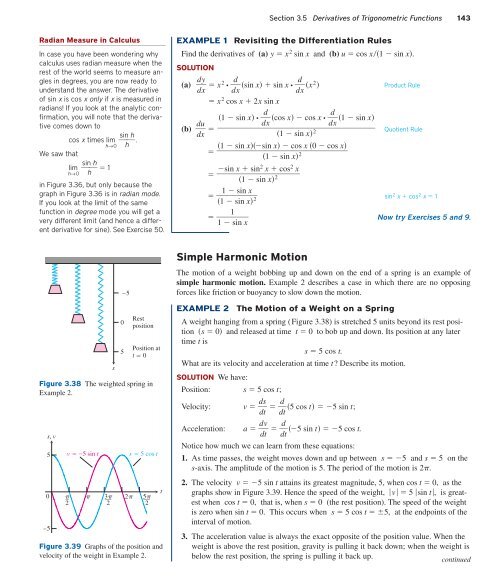5128_Ch03_pp098-184
Create successful ePaper yourself
Turn your PDF publications into a flip-book with our unique Google optimized e-Paper software.
Section 3.5 Derivatives of Trigonometric Functions 143<br />
Radian Measure in Calculus<br />
In case you have been wondering why<br />
calculus uses radian measure when the<br />
rest of the world seems to measure angles<br />
in degrees, you are now ready to<br />
understand the answer. The derivative<br />
of sin x is cos x only if x is measured in<br />
radians! If you look at the analytic confirmation,<br />
you will note that the derivative<br />
comes down to<br />
cos x times lim sin h<br />
.<br />
h→0 h<br />
We saw that<br />
lim sin h<br />
1<br />
h→0 h<br />
in Figure 3.36, but only because the<br />
graph in Figure 3.36 is in radian mode.<br />
If you look at the limit of the same<br />
function in degree mode you will get a<br />
very different limit (and hence a different<br />
derivative for sine). See Exercise 50.<br />
EXAMPLE 1 Revisiting the Differentiation Rules<br />
Find the derivatives of (a) y x 2 sin x and (b) u cos x1 sin x.<br />
SOLUTION<br />
(a) d y<br />
x<br />
dx<br />
2 d<br />
d<br />
• sin x sin x • x d x<br />
d x<br />
2 <br />
Product Rule<br />
x 2 cos x 2x sin x<br />
d<br />
d<br />
(b) d 1 sin x • cos x cos x • 1 sin x<br />
u<br />
d x<br />
d x<br />
<br />
Quotient Rule<br />
dx<br />
1 sin x 2<br />
1 sin xsin x cos x 0 cos x<br />
<br />
1 sin x 2<br />
sin x sin 2 x cos 2 x<br />
<br />
1 sin x 2<br />
1 sin<br />
x<br />
1 sin<br />
x 2<br />
sin 2 x cos 2 x 1<br />
1<br />
Now try Exercises 5 and 9.<br />
1 sin x<br />
–5<br />
Simple Harmonic Motion<br />
The motion of a weight bobbing up and down on the end of a spring is an example of<br />
simple harmonic motion. Example 2 describes a case in which there are no opposing<br />
forces like friction or buoyancy to slow down the motion.<br />
0<br />
5<br />
Rest<br />
position<br />
Position at<br />
t 0<br />
EXAMPLE 2<br />
The Motion of a Weight on a Spring<br />
A weight hanging from a spring (Figure 3.38) is stretched 5 units beyond its rest position<br />
s 0 and released at time t 0 to bob up and down. Its position at any later<br />
time t is<br />
s 5 cos t.<br />
What are its velocity and acceleration at time t? Describe its motion.<br />
—2 3<br />
s<br />
SOLUTION We have:<br />
Figure 3.38 The weighted spring in<br />
Example 2.<br />
Position: s 5 cos t;<br />
Velocity: v d s d<br />
5 cos t 5 sin t;<br />
dt<br />
d t<br />
Acceleration: a d v d<br />
5 sin t 5 cos t.<br />
s, v<br />
dt<br />
d t<br />
Notice how much we can learn from these equations:<br />
5<br />
0<br />
–5<br />
v –5 sin t<br />
–2 <br />
s 5 cos t<br />
2 —2 5<br />
1. As time passes, the weight moves down and up between s 5 and s 5 on the<br />
s-axis. The amplitude of the motion is 5. The period of the motion is 2p.<br />
2. The velocity v 5 sin t attains its greatest magnitude, 5, when cos t 0, as the<br />
t graphs show in Figure 3.39. Hence the speed of the weight, v 5 sin t, is greatest<br />
when cos t 0, that is, when s 0 (the rest position). The speed of the weight<br />
is zero when sin t 0. This occurs when s 5 cos t 5, at the endpoints of the<br />
interval of motion.<br />
3. The acceleration value is always the exact opposite of the position value. When the<br />
Figure 3.39 Graphs of the position and weight is above the rest position, gravity is pulling it back down; when the weight is<br />
velocity of the weight in Example 2.<br />
below the rest position, the spring is pulling it back up.<br />
continued












